Birds are one of the most fascinating creatures in the animal kingdom. They come in different shapes, sizes, colors, and habitats and are common in everyday life.
However, during winter, we get to experience the unique sight of birds in the snow. These beautifully feathered creatures are adapted to survive in cold weather conditions and can be seen in gardens, parks, and natural habitats worldwide.
From the elegant swan to the tiny chickadee, an impressive array of birds perfectly adapted to the snowy environment.
This article will explore some of the birds commonly found in snow during the winter season.
10 Birds In Snow
Winter is a harsh season for many animals, especially birds. Birds must find food, water, and shelter in the cold and snowy conditions. Some birds migrate to warmer regions, while others stay and adapt to the winter environment.
Here are ten birds you can see in the snow and how they survive the chilly weather.
1. Dark-Eyed Junco

The Dark-eyed Junco is a species of small, grayish sparrows found across much of temperate North America and in the Arctic during summer.
Carl Linnaeus formally described it in 1766 and named it after its distinctive dark eyes.
This bird has a very variable appearance due to the many different subspecies it contains, making its systematics challenging to unravel.
The plumage varies from white or light gray on their underparts with slate grey backs and wings, black heads with white outer tail feathers, brown head stripes, yellow bills, pink legs and feet, and various shades between all these colors.
They also have considerable sexual dimorphism,
; malestend to be more colorful than females but share similar characteristics such as short tails and rounded bodies – both sexes being around 16 cm long when fully grown.
Scientific classification:
| Kingdom | Animalia |
| Phylum | Chordata |
| Class | Aves |
| Order | Passeriformes |
| Family | Passerellidae |
| Genus | Junco |
| Species | J. hyemalis |
Also Featured In Most Common United States Birds, Birds That Live in Colorado
2. Cardinal
Cardinalidae is a family of passerine birds endemic to the New World, including cardinals, grosbeaks, and buntings.
This large group has great diversity in its members, ranging from tanager-like Piranga to warbler-like Granatellus.
They are usually distinguished by their bright plumage, with reds, oranges, and yellows shared among them.
Their substantial bills enable them to feed on seeds, fruits, insects, and other small prey items like lizards or frogs, depending upon the species.
Cardinals also have loud calls often used for territorial defense and courtship purposes, while some can even imitate sounds made by other animals.
These adaptable birds inhabit various
habitats across North America, making them an essentialpart of many ecosystems there.
Scientific classification:
| Kingdom | Animalia |
| Phylum | Chordata |
| Class | Aves |
| Order | Passeriformes |
| Superfamily | Emberizoidea |
| Family | Cardinalidae Ridgway, 1901 |
Also Featured In Common Birds in Canada, Most Common Songs Birds that Live around You
3. Pine Warbler
The Pine Warbler is a small New World Warbler family bird with an olive-brown upperparts and white belly.
Its distinguishing features include two white wing bars, dark legs, thin pointed bills, and yellowish ‘spectacles’ around its eyes.
Adult males have bright yellow throats and breasts on top of their olive upper parts; females and immatures are less vibrant in color but retain similar characteristics.
These birds can be found near pine forests throughout North America during the summer months before migrating to warmer climates for winter.
They feed mainly on insects such as caterpillars, spiders, and flies while consuming fruits like blueberries when food becomes scarce in colder times.
These
tiny songbirds provide us with much beauty through their unique plumage patterns while serving essentialroles within their ecosystems.
Scientific classification:
| Kingdom | Animalia |
| Phylum | Chordata |
| Class | Aves |
| Order | Passeriformes |
| Family | Parulidae |
| Genus | Setophaga |
| Species | S. pinus |
Also Featured In Most Common Types of Birds Found in Cuba, Birds Live in Arkansas
4. Purple Finch
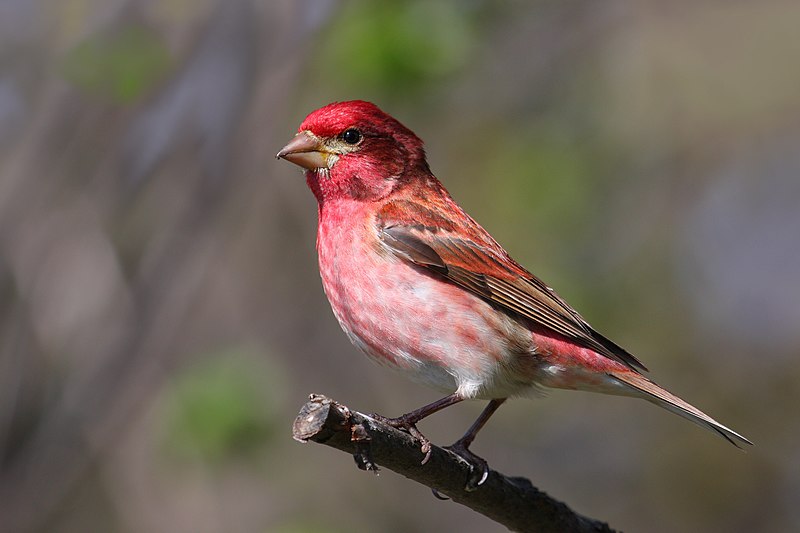
The Purple Finch is a species of finch from North America belonging to the Fringillidae family.
It’s also known as an “American Rosefinch” due to its resemblance in color and size to some European rosefinches.
Their plumage ranges from pinkish-purple on their heads and wings with a light brown underside.
Small birds measure about 5-6 inches long with short, thin beaks for eating seeds and insects.
In addition, they have thick, round bodies, which help them stay warm during cold winters in the northern parts of their range.
The Purple Finch has adapted well over time,
making it easier for them to survive despite increasing threats posed by humans,such as deforestation or habitat destruction caused by development projects near their habitats.
Scientific classification:
| Kingdom | Animalia |
| Phylum | Chordata |
| Class | Aves |
| Order | Passeriformes |
| Family | Fringillidae |
| Subfamily | Carduelinae |
| Genus | Haemorhous |
| Species | H. purpureus |
Also Featured In: Georgia Birds, Magenta Birds You Didn’t Know
5. Pine Siskin
The Pine Siskin is a small bird from the finch family, primarily found in North America. It has an irregular migratory range and was first described by American ornithologist Alexander Wilson in 1810.
Due to its frequent presence near coniferous trees, the species gets its name pinus, which means “pine tree” in Latin.
Pine siskins are known for their yellow wing bars, streaked chests, and perky mannerisms when perched on branches or flying around looking for food during colder months.
They feed primarily on seeds of weeds, grasses, and other plants but can also be seen consuming insects during the summertime nesting season.
Its loud calls often alert nearby birds of potential danger while they nest high up among pine tree limbs where predators cannot reach them easily.
Scientific classification:
| Kingdom | Animalia |
| Phylum | Chordata |
| Class | Aves |
| Order | Passeriformes |
| Family | Fringillidae |
| Subfamily | Carduelinae |
| Genus | Spinus |
| Species | S. pinus |
Also Featured In Finches Species, Most Common Winter Birds
6. American Tree Sparrow
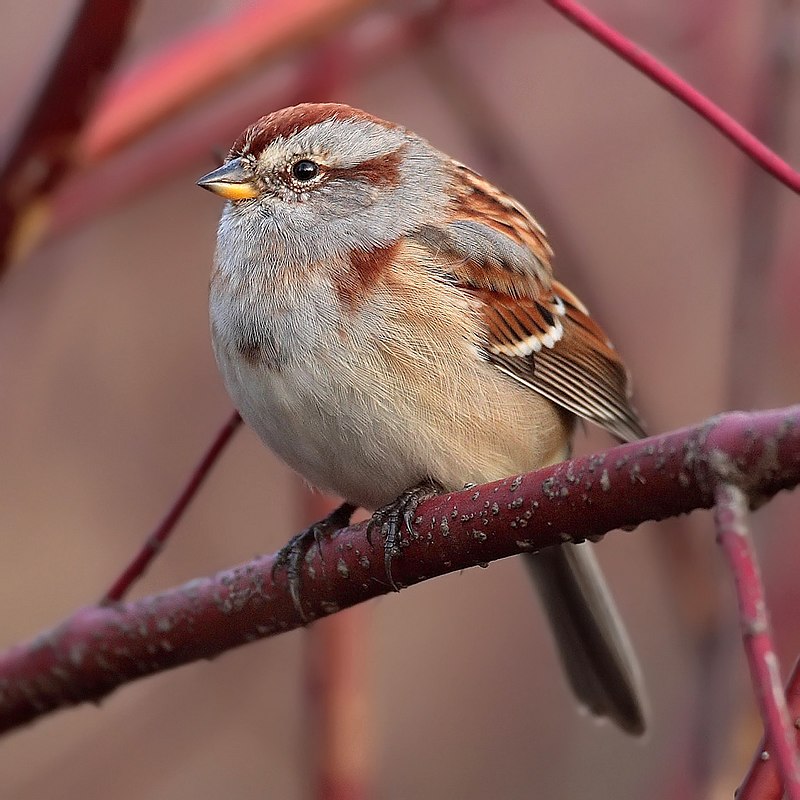
The American tree sparrow, also known as the winter sparrow, is a medium-sized New World bird. It has an attractive rusty cap, grey underparts, and a small dark spot on its chest.
Its back is rust-colored and striped with lighter shades of brown, while its wings have various shades of brown.
These birds are usually found in open areas such as grasslands or marshlands during spring migration and can form large flocks when seeking food sources like seeds, insects, or berries.
They nest in shrubs or trees near water sources but rarely do so far away from human settlements due to their dependence on supplementary foods provided by humans.
The American Tree Sparrow is a delightful sight for any nature enthusiast.
Scientific classification:
| Kingdom | Animalia |
| Phylum | Chordata |
| Class | Aves |
| Order | Passeriformes |
| Family | Passerellidae |
| Genus | Spizelloides Slager & Klicka, 2014 |
| Species | S. arborea |
Also Featured In Sparrows Species, Birds Commonly Found in New York
7. Winter Wren
The Winter Wren is a tiny New World wren family bird. It can be found in North America, from British Columbia to the Atlantic Ocean.
In winter, it migrates south and sometimes even reaches Central America. Its habitat consists mainly of coniferous forests where it builds its nest on or near ground level within dense vegetation for protection against predators.
This small songbird has a rich brown plumage with white eyebrows and buff underparts, which helps it blend into its environment perfectly.
The Winter Wrens are renowned for their loud songs that they sing daily
and night during the breeding season,making them an integral part of any forest ecosystem.
Scientific classification:
| Kingdom | Animalia |
| Phylum | Chordata |
| Class | Aves |
| Order | Passeriformes |
| Family | Troglodytidae |
| Genus | Troglodytes |
| Species | T. hiemalis |
Also Featured In Wrens Species, North Carolina Mountain Birds
8. Snow Goose
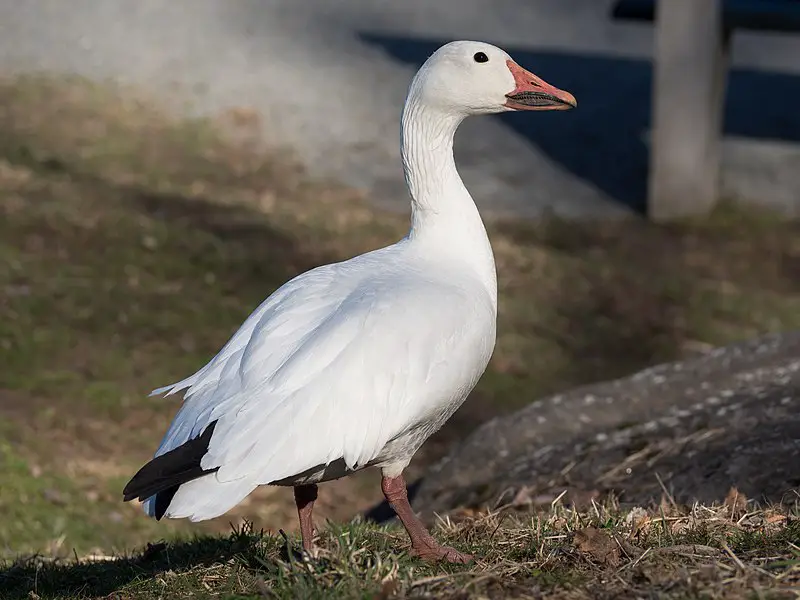
The snow goose is a species native to North America, recognizable by its white or dark plumage. It belongs to the genus Anser, the “gray goose.”
Snow geese breed north of the timberline in Greenland, Canada, and Alaska – places with harsh climates that would seem inhospitable for such birds.
Yet they thrive here due to their migration pattern; when winter arrives, they fly southwards along two significant routes towards warmer climates like California and Mexico, where food sources are more plentiful.
Although these graceful waterfowls have adapted well to human activity near some parts of their range, hunting still takes its toll on them,
so we must protectthis species from extinction.
Scientific classification:
| Kingdom | Animalia |
| Phylum | Chordata |
| Class | Aves |
| Order | Anseriformes |
| Family | Anatidae |
| Genus | Anser |
| Species | A. caerulescens |
Also Featured In: Utah Birds, Water Birds Live Around Us
9. Ross’s Goose
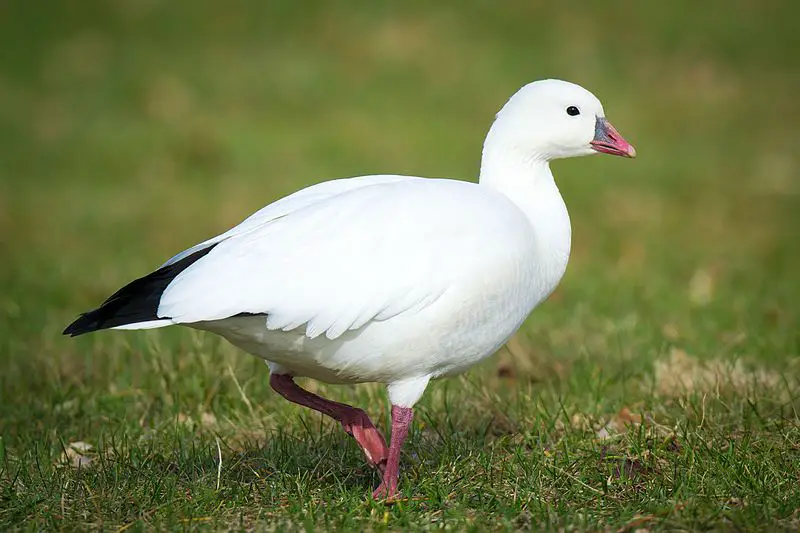
Ross’s Goose is a small white goose native to North America. It has black wingtips and a relatively short neck, distinguishing it from the other two “white geese” that breed in the area – Snow Geese.
Ross’es are smaller than their snowy counterparts, with bills proportionally smaller and lacking any “black lips.”
The dark phase of this species is extremely rare; usually, only one or two individuals out of every thousand will have plumage darker than usual.
Despite their small stature, they can be pretty vocal when nesting or migrating.
They’re known for honking noisily as they fly overhead during migration seasons – so keep an ear out if you go birdwatching.
Scientific classification:
| Kingdom | Animalia |
| Phylum | Chordata |
| Class | Aves |
| Order | Anseriformes |
| Family | Anatidae |
| Genus | Anser |
| Species | A. rossii |
Also Featured In birds of New Mexico,
10. Northern Pintail
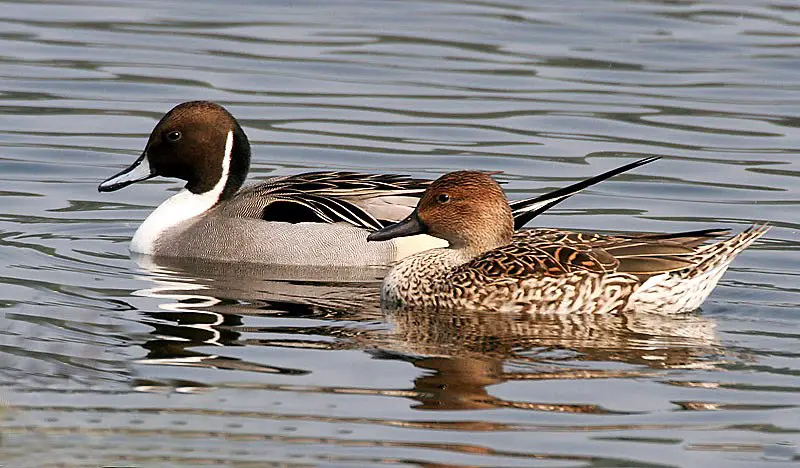
The Northern Pintail is a widespread duck species that breeds in northern parts of Europe, across the Palearctic and North America. This migratory bird winters south of its breeding range to the equator.
Unlike most birds with such a wide range, it has no subspecies. The male Northern Pintail has a distinctive long, thin tail and a chocolate-brown head. The female has a mottled brown body and a shorter tail.
This duck species prefers shallow wetlands or marshes for breeding and feeds on aquatic plants and insects.
The Northern Pintail is a highly migratory bird, covering great distances for suitable habitats.
Despite some threats, this species is not considered globally threatened, although specific populations are experiencing a decline in numbers.
Scientific classification:
| Kingdom | Animalia |
| Phylum | Chordata |
| Class | Aves |
| Order | Anseriformes |
| Family | Anatidae |
| Genus | Anas |
| Species | A. acuta |
Also Featured In Most Common Lake Birds, British Columbian Birds
Conclusion
The world of snowbirds is fascinating, encompassing a diverse array of bird species that have adapted to thrive in cold and snowy environments.
From the iconic and resilient American Robin to the charming Snow Bunting and the majestic Snowy Owl, these 13 ordinary snowbirds showcase the remarkable adaptability and resilience of avian life in winter climates.
As they migrate to escape harsh conditions and seek food sources, these birds play a vital role in maintaining ecological balance and serve as a source of inspiration for birdwatchers and nature enthusiasts.
Understanding and appreciating these snowbirds enriches our connection with the natural world and reminds us of the beauty and diversity of avian life in all seasons.